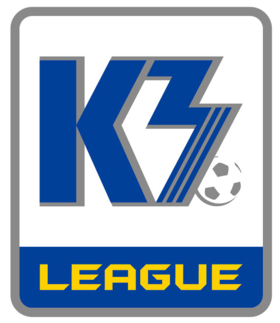Related Research Articles

The Korea Cup, formerly the Korean FA Cup, is a national football cup knockout competition of South Korea, held annually by the Korea Football Association (KFA). Before the competition was established in 1996, two similar tournaments named All Joseon Football Tournament (1921–1940) and Korean National Football Championship (1946–2000) were played. It was renamed Korea Cup in 2024, with the winners qualifying for the AFC Champions League Elite or the AFC Champions League 2.
Choi Yong-soo is a South Korean professional football manager and former player. He competed for South Korea at the 1996 Summer Olympics.

The K3 League was a South Korean amateur football league held annually from 2007 to 2019. It was considered the third-highest division of the South Korean football league system before the K League 2 was launched in 2013, and the fourth-highest division since then. In 2017, it was divided into K3 League Advanced and fifth-tier league K3 League Basic, and introduced a system of promotion and relegation. In 2020, it was reborn as a semi-professional league after merging with the Korea National League.

Paju Citizen Football Club is a South Korean football club based in the city of Paju. The club is a member of the K3 League, a semi-professional league and the third tier of semi professional football in South Korea.
K League (Korean: K리그) is South Korea's professional football league. It includes the first division K League 1 and the second division K League 2.
The 2016 K3 League was the tenth season of amateur K3 League.
The 2017 K3 League Basic was the first season of the K3 League Basic.
The 2019 K3 League Advanced was the 13th and last season of amateur K3 League. After the end of the 2019 season, the K3 League was relaunched as a semi-professional league by Korea Football Association (KFA).
The 2019 K3 League Basic was the third and last season of the K3 League Basic. After the 2019 season, amateur K3 Leagues were relaunched as semi-professional leagues in the name of K3 League and K4 League.
The 2020 K3 League was the first season of the K3 League as a semi-professional league. After the 2019 season, the former Korea National League and K3 League Advanced went defunct and rebranded as the K3 League.
The 2020 K4 League is the first season of the K4 League. The K4 League was regarded as the successor to the K3 League Basic, which was abolished in 2019.

The K4 League is the fourth-highest division in the South Korean football league system. It is regarded as the successor to the K3 League Basic, the second division of amateur K3 League founded in 2017.

The K3 League is the third-highest division in the South Korean football league system. It was run as an amateur league until 2019, but was relaunched as a semi-professional league after absorbing the Korea National League in 2020. It is currently contested by 16 clubs.
The 2021 K4 League is the second season of the K4 League.
This article shows a summary of the 2019 football season in South Korea.
The 2022 K4 League was the third season of the K4 League.
The 2022 K3 League was the third season of the K3 League as a semi-professional league. Its regular season was held from 26 February to 29 October 2022.
The 2023 K4 League was the fourth season of the K4 League.
The 2023 K3 League was the third season of the K3 League as a semi-professional league. Its regular season was held from 11 March to 11 November 2023.
References
- ↑ Park, Joo-seong (23 December 2015). "아마추어리그, 디비전 시스템 추진...2020년까지 4부 리그 확대" [Amateur league introduced division system... Fourth division to be expanded by 2020]. InterFootball (in Korean). Retrieved 22 April 2024.
- ↑ "Breaking: K3 and K4 League Teams Confirmed". K League United. 19 December 2019. Retrieved 22 April 2024.
- ↑ Paik, Ji-hwan (28 March 2024). "K League to unify promotion-relegation system across all 7 leagues". Korea JoongAng Daily. Retrieved 22 April 2024.
- ↑ 實業축구도 운영은 프로처럼… 본거지제도 채택. Naver.com (in Korean). Dong-A Ilbo. 15 December 1982. Retrieved 27 August 2021.
- ↑ 實業축구 코리 안리그 1.2部制 1년만에 다시통합┈변덕行政. Naver.com (in Korean). Kyunghyang. 16 November 1983. Retrieved 27 August 2021.